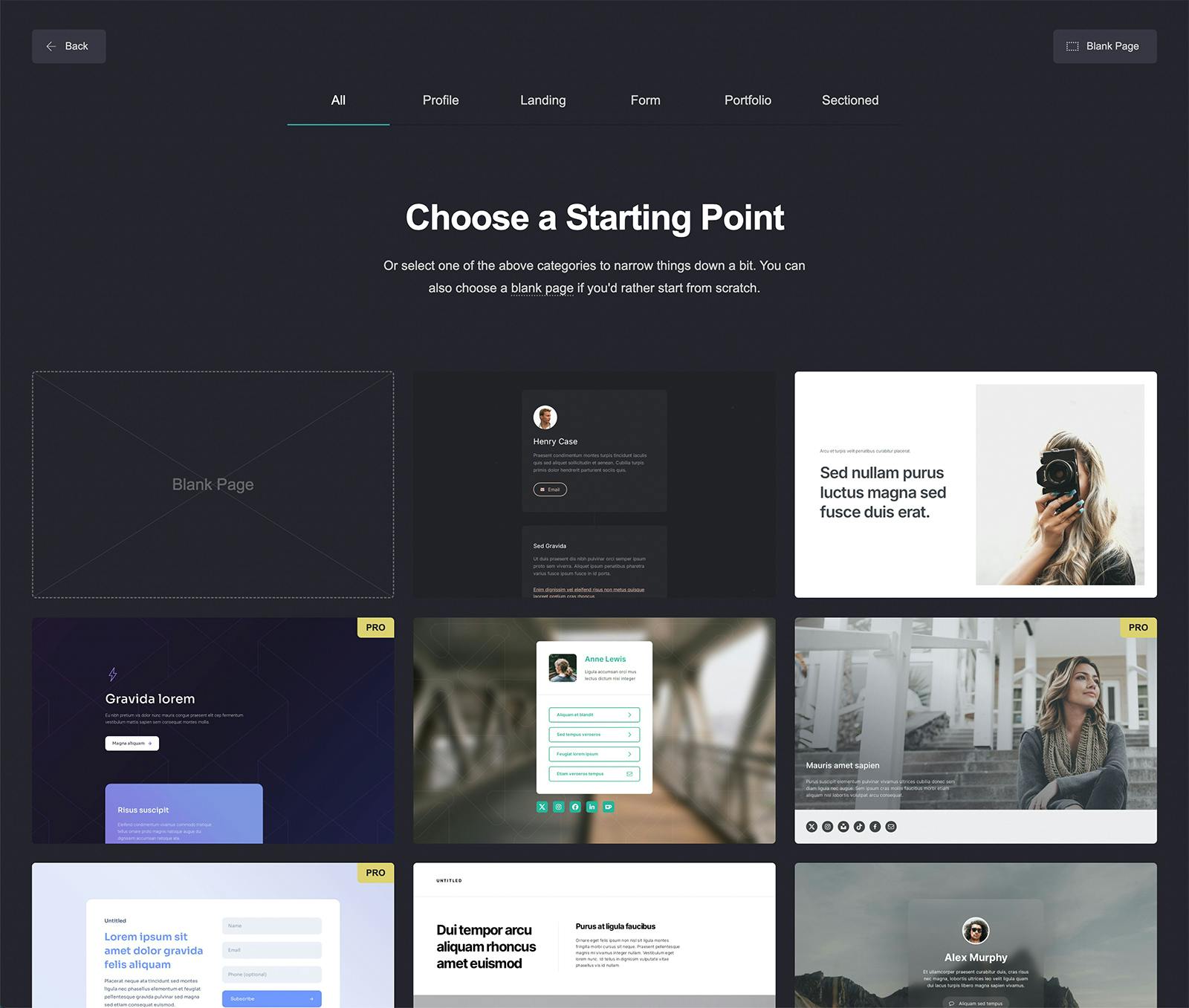Growing Carrd to $2M ARR in a crowded market with zero marketing by limiting
features

AJ had no intention of contending with the likes of Squarespace when he started building Carrd. That's probably why he hasn't invested any time or money into marketing. Nada.
Instead, he focused on building a beautiful, simple product that met the needs of a small, enthusiastic segment of the market. Now, he's making $2M ARR.
Here's AJ on how he did it. 👇
You first products are stepping stones
I became a founder because I wanted a new challenge.
I got my start working with website templates and themes, which led to launching HTML5 UP, a free site template I developed while learning to responsively design for the web. Then came Pixelarity, the paid version of HTML5 UP.
Pixelarity made some money, but not much. Combined with contract work, it was enough to keep me going.
More importantly, those products gave me the idea — and validation — for Carrd. And the sheer number of templates I had to design and code taught me the HTML and CSS techniques that would ultimately find their way into the sites people build on the platform.
A simple idea
The one-page templates I'd put out for free on HTML5 UP were unusually popular, and that always stuck with me. Plus, I realized that, as a solo dev, I couldn't exactly build a Squarespace-tier site builder. So it made sense to set my sights a bit lower — hence the concept of a one-page site builder.
If you set your sights too high as a solo dev, you'll either fall short or be forced out of the "solo dev" thing — which is totally okay, as some ideas definitely need more than a single dev to come to fruition. But if that's not something you're into, it's super helpful to aim lower.
So in 2015, with technical know-how, an idea, and some validation from my earlier products, I built Carrd — a one-page site builder, which is free with optional paid upgrades (pro plans). Doni, who had worked on HTML5 Up and Pixelarity with me, became my cofounder and we launched the beta in early 2016.
Eight years later, it's making over $2M ARR.
Entering a crowded market
Website builders have always been a crowded market. The traditional advice in a crowded market is to niche down hard, but I wasn't particularly worried.
It wasn't really my goal to "enter" that market, much less actively compete in it. I just wanted to build something interesting and put it out there.
If it did well enough to pay for itself, which wouldn't have taken much, that would've been enough for me. Where it went from there was something of (pleasant) surprise.
So we didn't niche down to a handful of industries (e.g. commerce or B2B), and keeping it generic ended up being a blessing. That ambiguity led to it being used for so many interesting and diverse use cases that I've lost count.
With that said, we did niche down from the beginning — just in a different way. We niched down in capability. All those use cases are under the umbrella of what's capable with a one-page site.
The importance of UX
I'm big on deciding on a given user experience and working backward from it, as opposed to treating UX as an afterthought. So I build wireframes and sketches first, then come up with the actual implementation.
This is always important, but it's particularly important for this product because it:
Is not exactly unique in what it does (building websites) so good UX is one way to stand out.
Bills itself as a simpler/easier way to do something that's considered complicated to a lot of folks.
And as far as Carrd itself, I paid a lot of attention to the onboarding UX, making it as low friction as possible.
You can use the entire product without even having to create an account or log in. Just visit carrd.co/build, pick a template, and have at it. If you end up building something you like, go ahead and publish it, which is where account creation factors in. If not, close the tab and move on with your life.

I think for users, this addresses an issue many of us have with typical onboarding: Being forced to share personal information with a product you might not end up using.
And for us as the makers of the product, it allows us to very effectively demonstrate the product to prospective users without having to invest time and money into elaborate marketing, demo videos, etc.
No marketing, no advertising
One of the reasons that our UX and onboarding approach is so important is that we don't do any marketing or advertising. At least not on purpose. We just haven't seen any need, and we'd prefer to focus on the product.
Honestly, I can't really explain how Carrd carved out a space for itself in this market, other than to credit the people using it — they're responsible for its growth. Carrd has grown entirely by word of mouth since launching in 2016.
The biggest thing we do is add an unobtrusive "Made with Carrd" link at the very bottom of free sites. That definitely plays a role. And we also have an opt-in referral program folks can join.
Other than that, it probably helps that we're very open to suggestions from the community and pretty quick about implementing ideas that make sense for the product.
But I'm well aware this is very specific to our situation. I wouldn't necessarily advise others to follow in our footsteps unless they, too, are in a similar situation.
Launching to an audience
One other thing played a role. HTML5 UP built me a decent audience on Twitter/X, which really gave Carrd a boost when it launched. Absent that, I'm not sure Carrd would be where it is today.
All I did was post regularly and throw a "Follow me for updates" button on the HTML5 UP. My audience just steadily grew.
Venture capital isn't always bad
This is certainly an unpopular opinion in certain indie hacker circles, but venture capital isn't always a bad thing. We took some VC money.
We were growing pretty rapidly and lacked the experience needed to deal with that growth, much less effectively build on it. So a friend pitched the idea of doing a small round, not so much for the money, as Carrd has always turned a profit, but for the connections and expertise we'd gain in the process.
A number of VCs had reached out prior, so we decided to start taking calls, and it all culminated in a small seed round in early 2021 with a dozen or so VCs and angels.
3+ years on, and I can say it's been an extremely beneficial experience. Carrd wouldn't be where it is today without the guidance and connections we've gained from doing that round.
Step back and look at the big picture
Know when to step back and see the bigger picture. I had trouble with this in the early days.
After many years of solo development on Carrd, I was advised to take a step back and evaluate whether that was the best thing for the product. It became very apparent it wasn't. The product and community were growing rapidly, and my insistence on soloing this thing had become a serious bottleneck.
That realization resulted in us hiring our first developer. Since then, we've built a small team of four people. And the things we've launched have completely blown away my expectations.
None of this would've happened if I hadn't made the effort to stop, take a step back, and honestly evaluate the entire situation. And that's no small task when you're in the trenches seven days a week working on a project.
Other than that, my advice is to keep building stuff. You'll be surprised where it leads you. That's what I'm going to keep doing.
You can follow along on X and at my website. And check out Carrd.

Leave a Comment
Wix 2023 revenue - $1.56B+
Carrd 2023 revenue - $2M
Carrd is just Aprox. 0.1% of Wix.
Lesson - being a small fish in a big pond also help small companies
wow wix is that big? have no idea about that lol
This is such a refreshing take on growing a business in a crowded market! AJ's focus on user experience and limiting features shows that you don't need a massive product or marketing budget to find success. Carrd’s growth is truly impressive!
Always a fan of AJ's work! Loved how they just do their own thing, upending conventional indie hacker myths along the way (though not intending to)
AJ’s success with Carrd shows how focusing on simplicity and user needs can create a winning product. Just like Carrd, Kodexia’s AI chatbots prioritize ease of use and effective customer engagement, helping businesses thrive without unnecessary complexity. By offering efficient, user-friendly AI tools, Kodexia empowers companies to enhance their operations and customer service seamlessly.
Hey Indie Hackers! Built a web or mobile app but moved on to something new? Don’t let your hard work go to waste—list your app on AppShopp co (link in my bio) and start earning effortlessly. We’ll handle the rest!
Carrd’s success story is a remarkable example of how simplicity and a focus on user experience can lead to big results, even without traditional marketing or advertising. AJ, the founder, built a $2M ARR business by keeping his product streamlined and letting word of mouth do the work. His approach shows that sometimes, focusing on delivering value to a niche audience and providing a seamless user experience can be more effective than expensive marketing campaigns.
I wish I found and used Carrd when it launched, would have saved me tons of money and headache. Really awesome product :)
Nice. Good lesson for all the hackers that think it's all about marketing and product doesn't matter.
Great products market themselves.
You did the best markting: Word of mouth marketing.
If your product is awesome, people will come back and tell their friends.
Kudos!
Thanks for sharing this informative information
There are three things I am taking away for me:
1. Focus on UX
I just built products without making a lot of wireframes or thinking about the user journey. Realized later when I did user testing it was crappy.
2. organic approach to growth and marketing
My first product gained virality without me doing a lot. But sustaining that over long term is hard. Sometimes the attention can also be distracting, which takes me to the next point
3. Focus on the product
Don't waste time with things that don't benefit the user in some way or another
Amazing story! Keep going. Beginners like me learn a lot from guys like you
First off congrats! Sensational story. How much of a nest egg did you have saved up before quitting your job to cover basic necessities, if you did?
This is all about good with my knowledge of your article
>You can use the entire product without even having to create an account or log in.
This is seriously important, and honestly, it’s amazing!
What a great piece, thanks for sharing. Indeed Cardd is winning the hearts with simplicity and UX.
AJ is my hero!
This comment was deleted 4 months ago